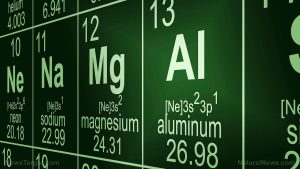
Aluminum sources, health risks
Tuesday, October 03, 2017 by Earl Garcia
http://www.naturalpedia.com/aluminum-sources-health-risks.html

Aluminum is a metallic element and is actually the most abundant heavy metal in the planet. According to the open chemistry database Pub Chem, aluminum is light-weight and has a silvery-white appearance. The heavy metal is often found in combination with other elements such as oxygen, silicon, and fluorine. The database also notes that traces of aluminum can be found dissolved in water.
Aluminum is used in making common kitchen staples such as foils, beverage cans, and pots and pans. Likewise, the heavy metal is utilized in the production of more complex industrial materials such as siding and roofing. Aluminum is often combined with small amounts of other metals to produce aluminum alloys, which possess stronger and harder properties.
The heavy metal is also used in other applications such as water treatment and cosmetics manufacturing. Both the pharmaceutical and cosmetics industries are known to utilize aluminum in making various consumer products such as food additives, astringents, and antiperspirants as well as antacids and buffered aspirin.

Harmful effects that can be caused by aluminum
Aluminum is widely regarded as toxic to brain health. A vast number of studies in both human and animal models have demonstrated a link between aluminum exposure and Alzheimer’s disease onset. According to previous studies, patients who have Alzheimer’s disease exhibited greater concentrations in brain plaque, neurofibrillary tangles, and total aluminum concentration compared with healthier controls.
Likewise, occupational exposure to aluminum is associated with other neurological issues such as decline in balance, loss of coordination and loss of memory. Various studies have also established that aluminum exposure from non-occupational sources, such as contaminated water, may lead to an increased risk of suffering from cognitive problems and dementia.
Aluminum exposure is found to greatly affect the respiratory tract as well. Previous studies have shown that occupational exposure to aluminum triggers wheezing, dyspnea, and impaired lung function. Health experts also note that aluminum exposure may lead to the development of lung cancer, diffuse pulmonary fibrosis, and interstitial emphysema as well as alveolar proteinosis and lipid pneumonia.
Exposure to the heavy metal is also correlated with higher odds of kidney and urinary problems. According to past studies, aluminum exposure often leads to impaired renal function. The toxic compound is known to cause bone problems and anemia as well. Past studies have shown that exposure to the heavy metal results in bone deformity and increased skeletal weakness and brittleness.
It is also shown that aluminum contains an astringent property that shrinks or constricts body tissues. This, in turn, raises the odds of developing various skin diseases, certain types of cancer, and fertility disorders.
Body systems harmed by aluminum
Aluminum is particularly harmful to brain development and the central nervous system’s overall health. Likewise, occupational exposure to the heavy metal is known to burden the respiratory tract. The metallic element is also known to trigger diseases of the kidney and the urinary tract. Aluminum negatively impacts the bones, skin, and the reproductive health as well.
Where to learn more
- Aluminum Toxicity: Symptoms and Solutions
- What’s really in vaccines? Proof of MSG, formaldehyde, aluminum and mercury
- Adya Clarity caught deceiving Health Canada in licensing scam that hid aluminum content
- Urgent health warning issued over Adya Clarity detox liquid containing aluminum, sulfuric acid
- FDA tests Adya Clarity, confirms high level of aluminum, multiple label violations
Summary
Aluminum causes various neurological disorders such as Alzheimer’s disease and dementia.
Aluminum triggers the onset of lung cancer, diffuse pulmonary fibrosis, and other respiratory illnesses.
Aluminum raises the risk of developing kidney problems, bone deformity, and blood disorders.
Aluminum increases the odds of suffering from skin diseases and infertility.
Aluminum is particularly harmful to the brain and the central nervous system’s overall health.
Aluminum affects the respiratory tract and the urinary system.
Aluminum impacts the bones, skin, and the reproductive health.
Sources include:
Tagged Under: Tags: Aluminum





